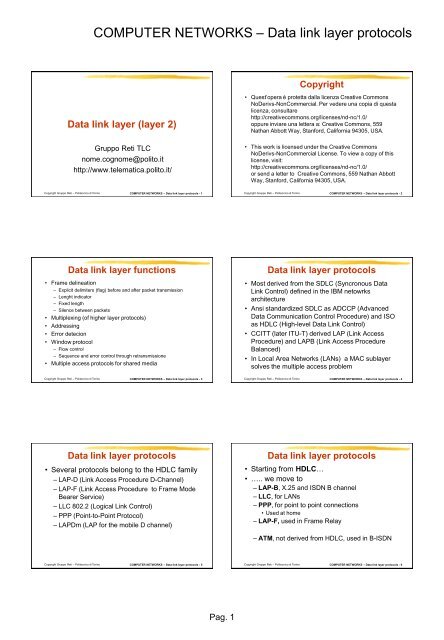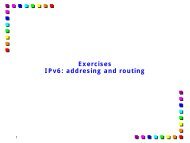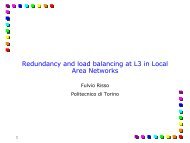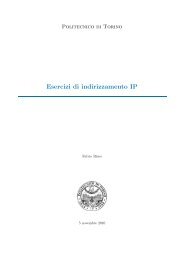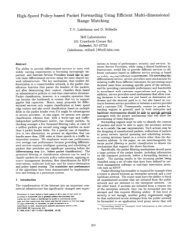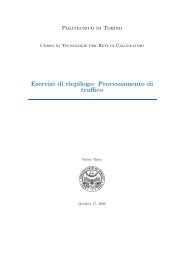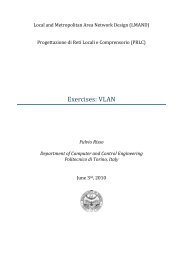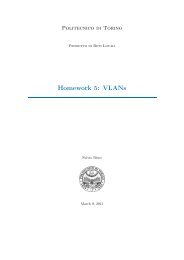COMPUTER NETWORKS â Data link layer protocols
COMPUTER NETWORKS â Data link layer protocols
COMPUTER NETWORKS â Data link layer protocols
You also want an ePaper? Increase the reach of your titles
YUMPU automatically turns print PDFs into web optimized ePapers that Google loves.
<strong>COMPUTER</strong> <strong>NETWORKS</strong> – <strong>Data</strong> <strong>link</strong> <strong>layer</strong> <strong>protocols</strong>HDLC: three types of PDUs• Information– <strong>Data</strong> sent after connection opening• Supervision– ACKs (positive and negative)• Unnumbered– Link management– <strong>Data</strong> sent in connectionless modeHDLC: two numbering schemes• Normal numbering (modulo 8) and extendednumbering (modulo 128)• Control field equal to either 1 o 2 byteInformation0 P/FSupervisionN(S)N(R)1 0 S S x x x x P/F N(R)Unnumbered1 1 M M P/F M M MCopyright Gruppo Reti – Politecnico di Torino<strong>COMPUTER</strong> <strong>NETWORKS</strong> – <strong>Data</strong> <strong>link</strong> <strong>layer</strong> <strong>protocols</strong> - 13Copyright Gruppo Reti – Politecnico di Torino<strong>COMPUTER</strong> <strong>NETWORKS</strong> – <strong>Data</strong> <strong>link</strong> <strong>layer</strong> <strong>protocols</strong> - 14HDLC vs LAP-B• LAP-B (ISDN B channel) uses only a subsetof PDUs defined by HDLC• We briefly describe the PDUs used by LAP-BLAP-B: information PDU• <strong>Data</strong> transfer• N(S) and N(R) fields needed by the windowprotocol to provide error and sequencecontrol– N(S) = transmitted PDU sequence number– N(R) = acknowledge number, refers to theexpected PDU at the receiver0 N(S) P/F N(R)Copyright Gruppo Reti – Politecnico di Torino<strong>COMPUTER</strong> <strong>NETWORKS</strong> – <strong>Data</strong> <strong>link</strong> <strong>layer</strong> <strong>protocols</strong> - 15Copyright Gruppo Reti – Politecnico di Torino<strong>COMPUTER</strong> <strong>NETWORKS</strong> – <strong>Data</strong> <strong>link</strong> <strong>layer</strong> <strong>protocols</strong> - 16LAP-B: supervision PDUs (S)• ACK transfer• RR (Receiver Ready - C/R)– Positive ACK• RNR (Receiver Not Ready - C/R)– Positive ACK and flow control signal sent from thereceiver which is unavailable (ON-OFF flow control)• REJ (Reject - C/R)– Request for retransmission of all PDU starting from N(R)1 0 S S P/F N(R)LAP-B: unnumbered PDUs (U)• Mainly used to control connectionmanagement• 5 M bits. A limited number of PDUs is usedby LAP-B among the 32 available PDUs• Command PDUs:– SABM(E) (Set Asynchronous Balanced Mode),used to (re)open the connection• E = Extended numbering scheme– DISC (Disconnect): the connection is aborted1 1 M M P/F M M MCopyright Gruppo Reti – Politecnico di Torino<strong>COMPUTER</strong> <strong>NETWORKS</strong> – <strong>Data</strong> <strong>link</strong> <strong>layer</strong> <strong>protocols</strong> - 17Copyright Gruppo Reti – Politecnico di Torino<strong>COMPUTER</strong> <strong>NETWORKS</strong> – <strong>Data</strong> <strong>link</strong> <strong>layer</strong> <strong>protocols</strong> - 18Pag. 3
<strong>COMPUTER</strong> <strong>NETWORKS</strong> – <strong>Data</strong> <strong>link</strong> <strong>layer</strong> <strong>protocols</strong>LAP-B: unnumbered PDUs (U)• Response PDUs– UA (Unnumbered Acknowledgment):• ACK for PDUs opening the connection or to answer toDISC commands– DM (Disconnect Mode)• Connection was not set up correctly– FRMR (FRaMe Reject)• Answer to the reception of a correct but unknownPDU• 24 additional bits to explain the reason why the PDUwas rejectedLAPB: command and response PDUsformat command response code in control field1 2 3 4 5 6 7 8Information I (Information) 0 N(S) P N(R)Supervision RR (Receiver Ready) RR (Receiver Ready) 1 0 0 0 P/F N(R)UnnumberedRNR (Rec. Not Ready) RNR (Rec. Not Ready) 1 0 1 0 P/F N(R)REJ (Reject) REJ (Reject) 1 0 0 1 P/F N(R)SABM (Set Asynchr.Balanced Mode) 1 1 1 1 P 1 0 0DISC (Disconnect) 1 1 0 0 P 0 1 0DM (Disconnect Mode) 1 1 1 1 F 0 0 0UA (UnnumberedAcknowledgement) 1 1 0 0 F 1 1 0FRMR (Frame Reject) 1 1 1 0 F 0 0 1Copyright Gruppo Reti – Politecnico di Torino<strong>COMPUTER</strong> <strong>NETWORKS</strong> – <strong>Data</strong> <strong>link</strong> <strong>layer</strong> <strong>protocols</strong> - 19Copyright Gruppo Reti – Politecnico di Torino<strong>COMPUTER</strong> <strong>NETWORKS</strong> – <strong>Data</strong> <strong>link</strong> <strong>layer</strong> <strong>protocols</strong> - 20LAPB: Poll/Final Bit• In command PDUs– the P/F bit is used to poll stations (i.e. to require an answer) whenset to 1• In response PDUs– the P/F bit is used to answer (final) to command PDUs with a P/F bitset to 1• Poll bit set to 1 by DTE (or DCE) is a request to answerimmediately for DCE (or DTE).• Final bit set to 1 specifies the answer to the poll request• DTE and DCE cannot send a command PDU with the P bitset to 1 unless a response PDU with the F bit set to 1 wasreceivedLAPB addresses• DTE has address 00000011 (3)• DCE has address 00000001 (1)• 3 is the value of the address field in– command PDUs DCE DTE and in– response PDUs DTE DCE• 1 is the value of the address field in– command PDUs DTE DCE and in– response PDUs DCE DTE• The address field permits to distinguish commandPDUs from response PDUs and to understandwhether the P/F bit is a poll or a finalCopyright Gruppo Reti – Politecnico di Torino<strong>COMPUTER</strong> <strong>NETWORKS</strong> – <strong>Data</strong> <strong>link</strong> <strong>layer</strong> <strong>protocols</strong> - 21Copyright Gruppo Reti – Politecnico di Torino<strong>COMPUTER</strong> <strong>NETWORKS</strong> – <strong>Data</strong> <strong>link</strong> <strong>layer</strong> <strong>protocols</strong> - 22Layered architecture:X.25 and ISDN B channelLAPB: example of data transferQ V Q VL3L2L1X.25packet <strong>layer</strong>LAP-BPhysicalUserterminalX.25 packet <strong>layer</strong>LAP-B LAP-BPhysical PhysicalSwitching nodeError controlX.25packet <strong>layer</strong>LAP-BPhysicalUser terminalV,SABM,PV,I00,PV,I10V,I21Q,RR2,FV,I32V,I42V,I52V,I62V,I72,Pmodo nonconnessoV,UA,FQ,I00Q,I10,PV,RR2,FV,RR3V,RR4Q,I25Q,I36V,I03V,I14V,I24V,RR5,PQ,RNR6,FV,RNR6,PV,DISC,Pmodo nonconnessoQ,I47V,RR2,FQ,I52,PV,RR3,FV,RR3,FV,UA,FCopyright Gruppo Reti – Politecnico di Torino<strong>COMPUTER</strong> <strong>NETWORKS</strong> – <strong>Data</strong> <strong>link</strong> <strong>layer</strong> <strong>protocols</strong> - 23Copyright Gruppo Reti – Politecnico di Torino<strong>COMPUTER</strong> <strong>NETWORKS</strong> – <strong>Data</strong> <strong>link</strong> <strong>layer</strong> <strong>protocols</strong> - 24Pag. 4
timeouttimeout<strong>COMPUTER</strong> <strong>NETWORKS</strong> – <strong>Data</strong> <strong>link</strong> <strong>layer</strong> <strong>protocols</strong>LAPB: error recovery via timeoutLAPB: error recovery via REJQVQVV,I00V,I10V,I20V,I30V,I40V,I50V,I60V,RR0,PV,I70trasferim.datiV,RR7V,RR7,FV,I00V,I10V,I21V,I32V,I23V,I34V,I45trasferim.datiQ,I00Q,I10Q,I21V,REJ2Q,I32Q,I42Q,I53Copyright Gruppo Reti – Politecnico di Torino<strong>COMPUTER</strong> <strong>NETWORKS</strong> – <strong>Data</strong> <strong>link</strong> <strong>layer</strong> <strong>protocols</strong> - 25Copyright Gruppo Reti – Politecnico di Torino<strong>COMPUTER</strong> <strong>NETWORKS</strong> – <strong>Data</strong> <strong>link</strong> <strong>layer</strong> <strong>protocols</strong> - 26LAPB: error recovery via P/F bitV,I00,PV,I11V,I22V,I33,PV,I45V,I15,PV,I26Qtrasferim.datiVQ,I00Q,I10V,I21,FQ,I31Q,I41V,RR1,FQ,I51V,RR2,FLAPB: error recovery viatime-out and REJV,I00V,I10V,I20V,I30V,I40V,I50V,I60V,I00V,I10Qtrasferim.datiVV,RR7V,REJ7V,I70Copyright Gruppo Reti – Politecnico di Torino<strong>COMPUTER</strong> <strong>NETWORKS</strong> – <strong>Data</strong> <strong>link</strong> <strong>layer</strong> <strong>protocols</strong> - 27Copyright Gruppo Reti – Politecnico di Torino<strong>COMPUTER</strong> <strong>NETWORKS</strong> – <strong>Data</strong> <strong>link</strong> <strong>layer</strong> <strong>protocols</strong> - 28<strong>Data</strong> <strong>link</strong> <strong>layer</strong> in LANs• IEEE 802.3 data <strong>link</strong> <strong>layer</strong> in LANs has twosub <strong>layer</strong>s– LLC: Logical Link Control– MAC: Medium Access Control321networkLLCMACphysicalIEEE 802.2 Logical Link Control• Derived from HDLC• Standard ISO 8802/2.• Main characteristics– Byte oriented protocol– Does not use flag for packet delineation (doneby the MAC)– No erroro control (done by the MAC)– PDU have source and destination addressesused for higher <strong>layer</strong> protocol multiplexing– Variable packet lenghthCopyright Gruppo Reti – Politecnico di Torino<strong>COMPUTER</strong> <strong>NETWORKS</strong> – <strong>Data</strong> <strong>link</strong> <strong>layer</strong> <strong>protocols</strong> - 29Copyright Gruppo Reti – Politecnico di Torino<strong>COMPUTER</strong> <strong>NETWORKS</strong> – <strong>Data</strong> <strong>link</strong> <strong>layer</strong> <strong>protocols</strong> - 30Pag. 5
<strong>COMPUTER</strong> <strong>NETWORKS</strong> – <strong>Data</strong> <strong>link</strong> <strong>layer</strong> <strong>protocols</strong>LLC PDU• One unused bit in the source address isexploited to distinguish between commandand response.• Control field– 8 bit in unnumbered PDUs– 16 bit otherwise• Maximun packet size depends on the MACLLC PDU• LLC addresses identify the higher <strong>layer</strong><strong>protocols</strong> transported bt the LLC protocol• Address field has two bit, unused foraddressing, reserved for control purposes• All 0s address identifies the LLC itself• Up to 63 addresses availableDSAP SSAP control informationaddress address8 bit 8 bit 8 o 16 bit 8 x M bitCopyright Gruppo Reti – Politecnico di Torino<strong>COMPUTER</strong> <strong>NETWORKS</strong> – <strong>Data</strong> <strong>link</strong> <strong>layer</strong> <strong>protocols</strong> - 31Copyright Gruppo Reti – Politecnico di Torino<strong>COMPUTER</strong> <strong>NETWORKS</strong> – <strong>Data</strong> <strong>link</strong> <strong>layer</strong> <strong>protocols</strong> - 32SNAP PDU• Extended addressing scheme, named SNAP(SubNetwork Access Protocol)• Used for connectionless transfer• Identifies IP protocol among others0AAH 0AAH 03H 000000H 0800H (3)-PDUDSAP SSAP controlloOUI protocol type(3) (2)informazionePoint to Point Protocol (PPP)RFC 1661• PPP (Point to Point Protocol) is mainly usedto connect customers to Internet ISP overtelephone or ADSL lines• Also available over ISDN connections andeven over SONET/SDH• Point-to-point connection is easier to managewith respect to braodcast or radio channel• PPP is simple (likely the simplest data <strong>link</strong><strong>layer</strong> protocol)Copyright Gruppo Reti – Politecnico di Torino<strong>COMPUTER</strong> <strong>NETWORKS</strong> – <strong>Data</strong> <strong>link</strong> <strong>layer</strong> <strong>protocols</strong> - 33Copyright Gruppo Reti – Politecnico di Torino<strong>COMPUTER</strong> <strong>NETWORKS</strong> – <strong>Data</strong> <strong>link</strong> <strong>layer</strong> <strong>protocols</strong> - 34PPP functionalities• PDU delineation• Content transparency• Error detection (but no correction)• Higher <strong>layer</strong> <strong>protocols</strong> multiplexing• Monitoring of <strong>link</strong> activity• Negotiation of <strong>layer</strong> three (IP) addresses– Useful for ISPsFunctions not available in PPP• Error correction• Flow control• Sequence control– Point to point <strong>link</strong>• Multipoint <strong>link</strong> managementCopyright Gruppo Reti – Politecnico di Torino<strong>COMPUTER</strong> <strong>NETWORKS</strong> – <strong>Data</strong> <strong>link</strong> <strong>layer</strong> <strong>protocols</strong> - 35Copyright Gruppo Reti – Politecnico di Torino<strong>COMPUTER</strong> <strong>NETWORKS</strong> – <strong>Data</strong> <strong>link</strong> <strong>layer</strong> <strong>protocols</strong> - 36Pag. 6
<strong>COMPUTER</strong> <strong>NETWORKS</strong> – <strong>Data</strong> <strong>link</strong> <strong>layer</strong> <strong>protocols</strong>PPP PDU• Flag for “framing” or PDU delineation• Address– Not used and kept for compatibility with HDLC• Control– Not used and kept for compatibility with HDLC• Protocol– Higher <strong>layer</strong> protocol multiplexingByte Stuffing• <strong>Data</strong> transparency is obtained by defining a mechanism tosend, in the data portion of the packet , the byte with value01111110• The sender inserts an escape byte 01111101 before any01111110 byte or 01111101 byte• The first byte equal to 01111101 is discarded by thereceiverCopyright Gruppo Reti – Politecnico di Torino<strong>COMPUTER</strong> <strong>NETWORKS</strong> – <strong>Data</strong> <strong>link</strong> <strong>layer</strong> <strong>protocols</strong> - 37Copyright Gruppo Reti – Politecnico di Torino<strong>COMPUTER</strong> <strong>NETWORKS</strong> – <strong>Data</strong> <strong>link</strong> <strong>layer</strong> <strong>protocols</strong> - 38PPP Link Control Protocol• PPP-LCP protocol opens (and close) the PPPconnection– Options are negotiated– Max frame length; authentication protocol; skip addressand control fields• DEAD is the initiaI state• Once the PPP connection has been establishedand the authentication process was successful, forthe IP protocol– the IP Control Protocol (RFC1332) is used to set up IPparameters (addresses, datagram compression, etc)PPP <strong>Data</strong> Control ProtocolCopyright Gruppo Reti – Politecnico di Torino<strong>COMPUTER</strong> <strong>NETWORKS</strong> – <strong>Data</strong> <strong>link</strong> <strong>layer</strong> <strong>protocols</strong> - 39Copyright Gruppo Reti – Politecnico di Torino<strong>COMPUTER</strong> <strong>NETWORKS</strong> – <strong>Data</strong> <strong>link</strong> <strong>layer</strong> <strong>protocols</strong> - 40Frame Relay• Standard to create packet networks based on virtual circuits(normally permanent VCs) on a wide area• The standard was originally proposed within the ISDNframework• Today used– to create VPNs (Virtual Private Networks) for companies– to interconnect LANs– to build logical topologies to interconnect Internet routers for ISP• Bit rate ranging from 64 kb/s to 2 Mb/s• Variable size packets (well suited to data traffic)– Maximum size 4096 byte• http://www.frforum.comFrame Relay• Operates on Permanent Virtual Circuit(although signaling <strong>protocols</strong> to deal withSVC are defined)DTEDTEDCEFrame RelaynetworkDCEVirtualCircuitsDCEDCEDTEDTECopyright Gruppo Reti – Politecnico di Torino<strong>COMPUTER</strong> <strong>NETWORKS</strong> – <strong>Data</strong> <strong>link</strong> <strong>layer</strong> <strong>protocols</strong> - 41Copyright Gruppo Reti – Politecnico di Torino<strong>COMPUTER</strong> <strong>NETWORKS</strong> – <strong>Data</strong> <strong>link</strong> <strong>layer</strong> <strong>protocols</strong> - 42Pag. 7
<strong>COMPUTER</strong> <strong>NETWORKS</strong> – <strong>Data</strong> <strong>link</strong> <strong>layer</strong> <strong>protocols</strong>LAPF• Frame Relay defines the LAPF protocol (LinkAccess Procedure to Frame mode bearerservices)• LAPF is divided in two parts:– DL-CORE (reccomendation I.233)• Used in all network nodes– DL-CONTROL• Optionally used only by end users (today, mainly IProuters)• In most applications, it is not usedL>=3L2L1Higher <strong>layer</strong><strong>protocols</strong>DL-CONTROLDL-COREPhysicalUser terminalCore and edge approachDL-COREPhysicalError controlDL-COREPhysicalFrame Relayswitching nodeHigher <strong>layer</strong><strong>protocols</strong>DL-CONTROLDL-COREPhysicalUser terminalCopyright Gruppo Reti – Politecnico di Torino<strong>COMPUTER</strong> <strong>NETWORKS</strong> – <strong>Data</strong> <strong>link</strong> <strong>layer</strong> <strong>protocols</strong> - 43Copyright Gruppo Reti – Politecnico di Torino<strong>COMPUTER</strong> <strong>NETWORKS</strong> – <strong>Data</strong> <strong>link</strong> <strong>layer</strong> <strong>protocols</strong> - 44LAPF packet• Packet delineation through flag andbitstuffing to guarantee data transparencyFlag Address Control Information CRC FlagDL-COREDL-CONTROL (like HDLC with extended numbering)• ADDRESS fieldcontains– the DLCI (<strong>Data</strong> LinkConnectionIdentifier),the virtualcircuit identifier– some additional bits forcongestion control andtraffic policingLAPF packetDL-COREDL-CONTROLFLAGADDR (MSB)ADDR (LSB)controlinformationCRC (MSB)CRC (LSB)FLAGCopyright Gruppo Reti – Politecnico di Torino<strong>COMPUTER</strong> <strong>NETWORKS</strong> – <strong>Data</strong> <strong>link</strong> <strong>layer</strong> <strong>protocols</strong> - 45Copyright Gruppo Reti – Politecnico di Torino<strong>COMPUTER</strong> <strong>NETWORKS</strong> – <strong>Data</strong> <strong>link</strong> <strong>layer</strong> <strong>protocols</strong> - 46• DLCI: <strong>Data</strong> LinkConnectionIdentifier• FECN/BECN:forward/backwardexplicit congestionnotification• DE: discardeligibility• C/R:command/response• D/C: DLCI or DL-CORE• EA: extension bitCopyright Gruppo Reti – Politecnico di TorinoADDRESS fieldlower DLCIDLCIupper DLCIupper DLCIlower DLCI or DL-CORE controlC/RFECN BECN DEC/RFECN BECN DED/CEA0EA1EA0EA0EA1upper DLCIC/REA0DLCI FECN BECN DEDLCIEA0EA0lower DLCI or DL-CORE control D/CEA1defaultformat(2 byte)format3 byteformat4 byte<strong>COMPUTER</strong> <strong>NETWORKS</strong> – <strong>Data</strong> <strong>link</strong> <strong>layer</strong> <strong>protocols</strong> - 47Copyright Gruppo Reti – Politecnico di TorinoB-ISDN• Private and public networks• Integrated network– Support all type of services, with different transmissionspeeds and quality of service requirements over thesame network infrastructure• Standardized by ITU-T and ATM Forum• ISDN (re)evolution• Exploit ATM as a transport, multiplexing andswitching technique<strong>COMPUTER</strong> <strong>NETWORKS</strong> – <strong>Data</strong> <strong>link</strong> <strong>layer</strong> <strong>protocols</strong> - 48Pag. 8
<strong>COMPUTER</strong> <strong>NETWORKS</strong> – <strong>Data</strong> <strong>link</strong> <strong>layer</strong> <strong>protocols</strong>Asynchronous Transfer Mode:ATM• Defined as a data <strong>link</strong> <strong>layer</strong> protocol• Wide area network exploiting packetswitching networks with virtual circuit service• Characteristics– High bit rate (starting from 622 Mb/s)– Low latencies for voice services– Fixed size data units (cells)• 53 byte (48 byte of data)• http://www.atmforum.comB-ISDN: reference modelControl planeHigher <strong>layer</strong>sManagementplaneUser planeHigher <strong>layer</strong>AAL (ATM Adaptation Layer)ATM <strong>layer</strong>Physical <strong>layer</strong>Layer managementPlane managementCopyright Gruppo Reti – Politecnico di Torino<strong>COMPUTER</strong> <strong>NETWORKS</strong> – <strong>Data</strong> <strong>link</strong> <strong>layer</strong> <strong>protocols</strong> - 49Copyright Gruppo Reti – Politecnico di Torino<strong>COMPUTER</strong> <strong>NETWORKS</strong> – <strong>Data</strong> <strong>link</strong> <strong>layer</strong> <strong>protocols</strong> - 50L>=3L2L1Higher <strong>layer</strong>s<strong>protocols</strong>AALATMPhysicalUserterminalCore and edge approachin the user planeError detection only on-demandfor some AALATMPhysicalATMPhysicalATM switching nodeHigher <strong>layer</strong>s<strong>protocols</strong>AALATMPhysicalUserterminalATM: which OSI <strong>layer</strong>?• Original idea– End-to-end transport– ATM from desktop todesktop• Reality:– IP router interconnection– IP over ATM– ATM is yet another data<strong>link</strong> technologyCopyright Gruppo Reti – Politecnico di Torino<strong>COMPUTER</strong> <strong>NETWORKS</strong> – <strong>Data</strong> <strong>link</strong> <strong>layer</strong> <strong>protocols</strong> - 51Copyright Gruppo Reti – Politecnico di Torino<strong>COMPUTER</strong> <strong>NETWORKS</strong> – <strong>Data</strong> <strong>link</strong> <strong>layer</strong> <strong>protocols</strong> - 52ATM cell format• Header (5 bytes) + payload (48 bytes)• Fixed size cell– To ease the switching task at high speed (synchronousswitching)• Small cell size– Reduced latency (can be obtained by increasingtransmission speed)– Small packetization delay for interactive voice services– Segmentation overhead• Slightly different format at network edge and coreATM cell formatGFC VPIVPIVPIVCIVPIVCIVCIVCIVCI PT CLP VCI PT CLPHECHECDATADATAUNI CELLNNI CELL5 BYTE48 BYTECopyright Gruppo Reti – Politecnico di Torino<strong>COMPUTER</strong> <strong>NETWORKS</strong> – <strong>Data</strong> <strong>link</strong> <strong>layer</strong> <strong>protocols</strong> - 53Copyright Gruppo Reti – Politecnico di Torino<strong>COMPUTER</strong> <strong>NETWORKS</strong> – <strong>Data</strong> <strong>link</strong> <strong>layer</strong> <strong>protocols</strong> - 54Pag. 9
<strong>COMPUTER</strong> <strong>NETWORKS</strong> – <strong>Data</strong> <strong>link</strong> <strong>layer</strong> <strong>protocols</strong>ATM cell format• ATM cell header (5 bytes = 40bit)– GFC (4 bit): Generic Flow Control– VPI (8-12 bit): Virtual Path Identifier– VCI (16 bit): Virtual Circuit Identifier– PT (3 bit): Payload Type– CLP (1 bit): Cell Loss Priority– HEC (8 bit): Header Error CodeATM cell format• GFC - Generic Flow Control– Only at the UNI interface.– The network issues information to user on thenumber of cells that can be sent– Two control algorithms:• ON-OFF• Credit basedCopyright Gruppo Reti – Politecnico di Torino<strong>COMPUTER</strong> <strong>NETWORKS</strong> – <strong>Data</strong> <strong>link</strong> <strong>layer</strong> <strong>protocols</strong> - 55Copyright Gruppo Reti – Politecnico di Torino<strong>COMPUTER</strong> <strong>NETWORKS</strong> – <strong>Data</strong> <strong>link</strong> <strong>layer</strong> <strong>protocols</strong> - 56ATM cell fromat• VPI - Virtual Path IdentifierATM cell format• VCI: Virtual Circuit Identifier– Variable length:• 8 bit at the UNI (256 VP’s)• 12 bit at the NNI (4096 VP’s)– Some VPIs are reserved to networkmanagement functions and to signalling– Identifies a single virtual circuit within a givenVPI.– 65536 VC’s are available for each VP.– Example: <strong>link</strong> at 2,4 Gb/s, 1 VP, all VCs with thesame capacity 36Kb/s for each VC.Copyright Gruppo Reti – Politecnico di Torino<strong>COMPUTER</strong> <strong>NETWORKS</strong> – <strong>Data</strong> <strong>link</strong> <strong>layer</strong> <strong>protocols</strong> - 57Copyright Gruppo Reti – Politecnico di Torino<strong>COMPUTER</strong> <strong>NETWORKS</strong> – <strong>Data</strong> <strong>link</strong> <strong>layer</strong> <strong>protocols</strong> - 58ATM cell formatPT field (Payload Type)• PT - Payload Type– Classifies the payload information type.– It contains an identifier named Payload TypeIdentifier (PTI).– Among the eight possible codes,• four are reserved to network functions• four to user function0000PT00110101User cellUser cellUser cellUser cellMEANINGEFCI No congestionAAL 5 indication=0EFCI No congestionAAL 5 indication=1EFCI CongestionAAL 5 indication=0EFCI CongestionAAL 5 indication=1Copyright Gruppo Reti – Politecnico di Torino<strong>COMPUTER</strong> <strong>NETWORKS</strong> – <strong>Data</strong> <strong>link</strong> <strong>layer</strong> <strong>protocols</strong> - 59Copyright Gruppo Reti – Politecnico di Torino<strong>COMPUTER</strong> <strong>NETWORKS</strong> – <strong>Data</strong> <strong>link</strong> <strong>layer</strong> <strong>protocols</strong> - 60Pag. 10
<strong>COMPUTER</strong> <strong>NETWORKS</strong> – <strong>Data</strong> <strong>link</strong> <strong>layer</strong> <strong>protocols</strong>Campo PT (Payload Type)ATM cell format• CLP - Cell Loss Priority111PT001010SIGNIFICATOOAM cell(Operation and Maintenance)OAM cell(Operation and Maintenance)RM cell(Resource Management)– Two priority levels at the ATM <strong>layer</strong> (within eachVC)– In ATM switches, it permits to selectively discardcells in case of buffer congestion– CLP=0 indicates a high priority cell111Not usedReserved for future useCopyright Gruppo Reti – Politecnico di Torino<strong>COMPUTER</strong> <strong>NETWORKS</strong> – <strong>Data</strong> <strong>link</strong> <strong>layer</strong> <strong>protocols</strong> - 61Copyright Gruppo Reti – Politecnico di Torino<strong>COMPUTER</strong> <strong>NETWORKS</strong> – <strong>Data</strong> <strong>link</strong> <strong>layer</strong> <strong>protocols</strong> - 62ATM cell format• HEC - Header Error Code– It permits to check the correctness of the ATMcell header only– No error detection on paylod!– Single errors are corrected– Two errors are detected• SEC/DED: Single errore correction/ Double ErrorDetectionB-ISDN: reference modelControl planeHigher <strong>layer</strong>sManagementplaneUser planeHigher <strong>layer</strong>AAL (ATM Adaptation Layer)ATM <strong>layer</strong>Physical <strong>layer</strong>Layer managementPlane managementCopyright Gruppo Reti – Politecnico di Torino<strong>COMPUTER</strong> <strong>NETWORKS</strong> – <strong>Data</strong> <strong>link</strong> <strong>layer</strong> <strong>protocols</strong> - 63Copyright Gruppo Reti – Politecnico di Torino<strong>COMPUTER</strong> <strong>NETWORKS</strong> – <strong>Data</strong> <strong>link</strong> <strong>layer</strong> <strong>protocols</strong> - 64AAL: ATM Adaptation Layer• Integrates ATM transport to offer service tousers• Servide dependent <strong>layer</strong>• Examples of AAL functions:– Transmission errors detection and managment– Segmentation and reassembly– Cell loss management– Flow control– SynchronizationAAL: ATM Adaptation Layer• It defines four classes of service (serviceclasses)– Through three main parametrs:• Source transmission speed• Type of connection (connectionoriented/connectionless)• Temporal relation between end userCopyright Gruppo Reti – Politecnico di Torino<strong>COMPUTER</strong> <strong>NETWORKS</strong> – <strong>Data</strong> <strong>link</strong> <strong>layer</strong> <strong>protocols</strong> - 65Copyright Gruppo Reti – Politecnico di Torino<strong>COMPUTER</strong> <strong>NETWORKS</strong> – <strong>Data</strong> <strong>link</strong> <strong>layer</strong> <strong>protocols</strong> - 66Pag. 11
<strong>COMPUTER</strong> <strong>NETWORKS</strong> – <strong>Data</strong> <strong>link</strong> <strong>layer</strong> <strong>protocols</strong>AAL: 4 service classes• A: CBR traffic, constant but rate, connectionoriented, synchronism required AAL 1• B: VBR traffic, connection oriented,synchronism required AAL 2• C: VBR traffic, connection oriented,synchronism not required AAL 3/4• D: VBR traffic, connectionless, synchronismnot required AAL 5Synchronismrequired betweensource and destSpeedConnectiontypeAAL typePossibleapplicationsAAL service classesClass A Class B Class C Class Dcostant(CBR)requiredConnection orientednot requiredvariable(VBR)AAL 1 AAL 2 AAL 3/4 - 5voice 64kbit/svideo CBRvideo/audioVBRdataconnectionlessdataCopyright Gruppo Reti – Politecnico di Torino<strong>COMPUTER</strong> <strong>NETWORKS</strong> – <strong>Data</strong> <strong>link</strong> <strong>layer</strong> <strong>protocols</strong> - 67Copyright Gruppo Reti – Politecnico di Torino<strong>COMPUTER</strong> <strong>NETWORKS</strong> – <strong>Data</strong> <strong>link</strong> <strong>layer</strong> <strong>protocols</strong> - 68AAL <strong>layer</strong>: architecture• The AAL <strong>layer</strong> is subdivided into two sub<strong>layer</strong>s– convergence sub<strong>layer</strong> (CS):• Service and ATM traffic convergence• Multiplexing• Error detection• Synchronism recovery– segmentation and reassembly (SAR):• Segmentation in transmission, reassembly inreception of CS PDUsAALAAL architecture• CS convergence sub<strong>layer</strong>• SAR segmentation and reassembly• SSCS service specific CS• CPCS common part CS• Some sub-<strong>layer</strong>s can be emptyCSSARSSCSCPCSCopyright Gruppo Reti – Politecnico di Torino<strong>COMPUTER</strong> <strong>NETWORKS</strong> – <strong>Data</strong> <strong>link</strong> <strong>layer</strong> <strong>protocols</strong> - 69Copyright Gruppo Reti – Politecnico di Torino<strong>COMPUTER</strong> <strong>NETWORKS</strong> – <strong>Data</strong> <strong>link</strong> <strong>layer</strong> <strong>protocols</strong> - 70AAL formatAAL 3/4ATM Cell Header SN SNPSAR - SDU47 byteAAL 1CPCS PDU1B 1B 2B 0-3B 1B 2B 2BCPIBTag BAsizeAAL payload pad ALELenghtTagATM Cell Header SN IT SAR - SDU LI CRC AAL 244 byteATM Cell Header ST SN RES SAR - SDU LI CRC AAL 344 byteATM Cell Header ST SN MID SAR - SDU LI CRCAAL 444 byteATM Cell HeaderAAL 548 byteCopyright Gruppo Reti – Politecnico di Torino<strong>COMPUTER</strong> <strong>NETWORKS</strong> – <strong>Data</strong> <strong>link</strong> <strong>layer</strong> <strong>protocols</strong> - 71SAR PDU2 byte 44 byte 2 byte SAR - PDUSARSARheadertrailerST=BOMCopyright Gruppo Reti – Politecnico di TorinoSARheaderST=COMSARtrailerSARheaderST=EOMST SN MID LI CRC2 4 10 bit 6 bit 10 bitSARtrailer<strong>COMPUTER</strong> <strong>NETWORKS</strong> – <strong>Data</strong> <strong>link</strong> <strong>layer</strong> <strong>protocols</strong> - 72Pag. 12
LenghtCRC - 32<strong>COMPUTER</strong> <strong>NETWORKS</strong> – <strong>Data</strong> <strong>link</strong> <strong>layer</strong> <strong>protocols</strong>SARLayerPDUCSLayerPDUAAL 5CS Layer Payload48 bytesSARpayload1- 65535B 0-47B 2B 2B 4B48 bytesSARpayload48 bytesSARpayloadEnd of segment = 1AAL 5• No CS <strong>layer</strong>• SAR <strong>layer</strong> exploit all 48 byte payload• Last cell created by the segmentationprocess has the third bit in the PT field of theATM header set to 1– Layer separation principle violated!• Error control over the full CS-PDUCopyright Gruppo Reti – Politecnico di Torino<strong>COMPUTER</strong> <strong>NETWORKS</strong> – <strong>Data</strong> <strong>link</strong> <strong>layer</strong> <strong>protocols</strong> - 73Copyright Gruppo Reti – Politecnico di Torino<strong>COMPUTER</strong> <strong>NETWORKS</strong> – <strong>Data</strong> <strong>link</strong> <strong>layer</strong> <strong>protocols</strong> - 74AAL 5• Advantages– simplicity– efficiency– Improved reliability (CRC - 32)• Disadvantages– Use the third bit of the PT field in the ATMheader• Breaks <strong>layer</strong> separation principle– Loss of the cell with the PT bit set =1 implies thattwo full CS-PDUs are lostLayer 2 <strong>protocols</strong>: a comparisonProtocolPacket delineation Layer 3 protocolmultiplexingError detectionLAPB Delimiter Higher <strong>layer</strong> YES YESLAPF core +LAPF controlATM (core)+AAL (edge)DelimiterDone at thephysical <strong>layer</strong>Via virtualcircuitsVia virtualcircuitsYES inLAPF coreYES inAAL (edge)PPP Delimiter YES YES NOLLCDone in MACIEEE 802.3Error correction(windowprotocol)Optional inLAPF control(edge)NOYES Optional OptionalEthernet MAC Silence YES YES NOIn gray info either not presented in this class or later descriebdCopyright Gruppo Reti – Politecnico di Torino<strong>COMPUTER</strong> <strong>NETWORKS</strong> – <strong>Data</strong> <strong>link</strong> <strong>layer</strong> <strong>protocols</strong> - 75Copyright Gruppo Reti – Politecnico di Torino<strong>COMPUTER</strong> <strong>NETWORKS</strong> – <strong>Data</strong> <strong>link</strong> <strong>layer</strong> <strong>protocols</strong> - 76Pag. 13


